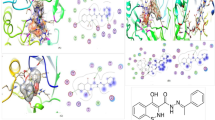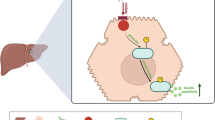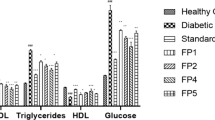Abstract
Aim:
To discover and optimize a series of novel PTP1B inhibitors containing a thiazolidinone-substituted biphenyl scaffold and to further evaluate the inhibitory effects of these compounds in vitro and in vivo.
Methods:
A total of 36 thiazolidinone substituted biphenyl scaffold derivatives were prepared. An in vitro biological evaluation was done by Enzyme-based assay. The in vivo efficacy of 7Fb as an antihyperglycemic agent was evaluated in a BKS db/db diabetic mouse model with a dose of 50 mg·kg-1·d-1 for 4 weeks.
Results:
The in vitro biological evaluation showed that compounds 7Fb and 7Fc could increase the insulin-induced tyrosine phosphorylation of IRβ in CHO/hIR cells. In in vivo experiments, compound 7Fb significantly lowered the postprandial blood glucose, from 29.4±1.2 mmol/L with the vehicle to 24.7±0.6 mmol/L (P<0.01), and the fasting blood glucose from 27.3±1.5 mmol/L with the vehicle to 23.6±1.2 mmol/L (P<0.05).
Conclusion:
A novel series of compounds were discovered to be PTP1B inhibitors. Among them, compound 7Fb significantly lowered the postprandial and fasting glucose levels, and the blood glucose level declined more rapidly than in metformin-treated mice. Thus, 7Fb may be a potential lead compound for developing new agents for the treatment of type II diabetes.
Similar content being viewed by others
Log in or create a free account to read this content
Gain free access to this article, as well as selected content from this journal and more on nature.com
or
References
Hunter T . Signaling — 2000 and Beyond. Cell 2000; 100: 113–27.
Tonks NK, Neel BG . Combinatorial control of the specificity of protein tyrosine phosphatases. Curr Opin Cell Biol 2001; 13: 182–95.
Kappert K, Peters KG, Bohmer FD, Ostman A . Tyrosine phosphatases in vessel wall signaling. Cardio Vasc Res 2005; 65: 587–98.
Stoker AW . Protein tyrosine phosphatases and signaling. J Endocrinol 2005; 185: 19–33.
Tonks NK . Protein tyrosine phosphatases: from genes, to function, to disease. Nat Rev Mol Cell Bio 2006; 7: 833–46.
Wang WJ, Kuo JC, Ku W, Lee YR, Lin FC, Chang YL, et al. The tumor suppressor dapk is reciprocally regulated by tyrosine kinase src and phosphatase LAR. Mol Cell 2007; 27: 701–16.
Zhang ZY . Protein tyrosine phosphatases: prospects for therapeutics. Curr Opin Chem Biol 2001; 5: 416–23.
Hooft van Huijsduijnen R, Bombrun A, Swinnen D . Selecting protein tyrosine phosphatases as drug targets. Drugs Discov Today 2002; 7: 1013–9.
Hendriks WJ, Elson A, Harroch S, Stoker AW . Protein tyrosine phosphatases: functional inferences from mouse models and human diseases. FEBS J 2008; 275: 816–30.
Julien SG . Protein tyrosine phosphatase 1B deficiency or inhibition delays ErbB2-induced mammary rumorigenesis and protects from lung metastasis. Nat Genet 2007; 39: 338–46.
Johnson TO, Ermolieff J, Jirousek MR . Protein tyrosine phosphatase 1B inhibitors for diabetes. Nat Rev Drug Discov 2002; 1: 696–709.
Liu G, Trevillyan JM . Protein tyrosine phosphatase 1B as a target for the treatment of impaired glucose tolerance and type II diabetes. Curr Opin Investig Drugs 2002; 3: 1608–16.
Tobin JF, Tam S . Recent advances in the development of small molecule inhibitors of PTP1B for the treatment of insulin resistance and type 2 diabetes. Curr Opin Drug Discov Devel 2002; 5: 500–12.
Zhang Z . Protein tyrosine phosphatases: structure and function, substrate specificity, and inhibitor development. Annu Rev Pharmacol Toxicol 2002; 42: 209–34.
Zhang Z, Zhou B, Xie L . Modulation of protein kinase signaling by protein phosphatases and inhibitors. Pharmacol Therap 2002; 93: 307–17.
Kennedy BP, Ramachandran C . Protein tyrosine phosphatase-1B in diabetes. Biochem Pharmacol 2000; 60: 877–83.
Elchebly M, Payette P, Michaliszyn E, Cromlish W, Collins S, Loy AL, et al. Increased insulin sensitivity and obesity resistance in mice lacking the protein tyrosine phosphatase 1B gene. Science 1999; 283: 1544–8.
Klaman LD, Boss O, Peroni OD, Kim JK, Martino JL, Zabolotny JM, et al. Increased energy expenditure decreased adiposity and tissue-specific insulin sensitivity in protein — tyrosine phosphatase 1B deficient mice. Mol Cell Biol 2000; 20: 5479–89.
Zinker BA, Rondinone CM, Trevillyan JM, Gum RJ, Clampit JE, Waring JF . PTP1B antisense oligonucleotide lowers PTP1B protein, normalizes blood glucose, and improves insulin sensitivity in diabetic mice. Proc Natl Acad Sci USA 2002; 99: 11357–62.
Gum RJ, Gaede LL, Koterski SL, Heindel M, Clampit JE, Zinker BA, et al. Reduction of protein tyrosine phosphatase 1b increases insulin-dependent signaling in ob/ob mice. Diabetes 2003; 52: 21–8.
Lessard L, Stuible M, Tremblay ML . The two faces of PTP1B in cancer. Biochim Biophys Acta 2010; 1804: 613–9.
Zhang S, Zhang ZY . PTP1B as a drug target: recent developments in PTP1B inhibitor discovery. Drug Discov Today 2007; 12: 373–81.
Lee S, Wan Q . Recent development of small molecular specific inhibitor of protein tyrosine phosphatase 1B. Med Res Rev 2007; 27: 553–73.
Zhang Y, Li Y, Guo YW, Jiang HL, Shen X . A sesquiterpene quinone, dysidine, from the sponge Dysidea villosa, activates the insulin pathway through inhibition of PTPases. Acta Pharmacol Sin 2009; 30: 333–45.
Shi L, Yu HP, Zhou YY, Du JQ, Shen Q, Li JY, et al. Discovery of a novel competitive inhibitor of PTP1B by high-throughput screening. Acta Pharmacol Sin 2008; 29: 278–84.
Hartshorn MJ, Murray CW, Cleasby A, Frederickson M, Tickle IJ, Jhoti H . Fragment-based lead discovery using X-ray crystallography. J Med Chem 2005; 48: 403–13.
Wilson DP, Wan ZK, Xu WX, Kirincich SJ, Follows BC, Joseph-McCarthy D, et al. Structure-based optimization of protein tyrosine phosphatase 1B inhibitors: from the active site to the second phosphotyrosine binding site. J Med Chem 2007; 50: 4681–98.
Hussain M, Ahmed V, Hill B, Ahmed Z, Taylor SD . A re-examination of the difluoromethylenesulfonic acid group as a phosphotyrosine mimic for PTP1B inhibition. Bioorg Med Chem 2008; 16: 6764–77.
Reddy KA, Lohray BB, Bhushan V, Bajji AC, Reddy KV, Reddy PR, et al. Novel antidiabetic and hypolipidemic agents. 3. Benzofuran-containing thiazolidinediones. J Med Chem 1999; 42: 1927–40.
Willson TM, Brown PJ, Sternbach DD, Henke BR . The PPARs: from orphan receptors to drug discovery. J Med Chem 2000; 43: 527–50.
Costantino L, Rastelli G, Vianello P, Cignarella G, Barlocco D . Diabetes complications and their potential prevention: aldose reductase inhibition and other approaches. Med Res Rev 1999; 19: 3–23.
Malamas MS, Sredy J, Gunawan I, Mihan B, Sawicki DR, Seestaller L, et al. New azolidinediones as inhibitors of protein tyrosine phosphatase 1B with antihyperglycemic properties. J Med Chem 2000; 43: 995–1010.
Liu Z, Huang Y, Zhang W, Ma LP, Li JY, Wang X, et al. Soluble polymer-supported synthesis of 5-arylidene thiazolidinones and pyrimidinones using a novel traceless linker strategy. J Comb Chem 2008; 10: 632–6.
Zhang W, Hong D, Zhou Y, Zhang Y, Shen Q, Li JY, et al. Ursolic acid and its derivative inhibit protein tyrosine phosphatase 1B enhancing insulin receptor phosphorylation and stimulating glucose uptake. Biochim Biophys Acta 2006; 1760: 1505–12.
Acknowledgements
This work was supported by the 863 High-Tech Research and Development Program of China (Grant 2006AA02Z315 and 2008AA02Z105), the National S&T Major Projects “Key New Drug Creation and Manufacturing Program” of China (No 2009ZX09301-001, 2009ZX09302-001 and 2009ZX09501-010) and the Public Service Platform Foundation of Shanghai Ministry of Science and Technology (08DZ2291300 and 09DZ2291200).
Author information
Authors and Affiliations
Corresponding authors
Rights and permissions
About this article
Cite this article
Liu, Z., Chai, Q., Li, Yy. et al. Discovery of novel PTP1B inhibitors with antihyperglycemic activity. Acta Pharmacol Sin 31, 1005–1012 (2010). https://doi.org/10.1038/aps.2010.81
Received:
Accepted:
Published:
Issue date:
DOI: https://doi.org/10.1038/aps.2010.81
Keywords
This article is cited by
-
Thiazole-based and thiazolidine-based protein tyrosine phosphatase 1B inhibitors as potential anti-diabetes agents
Medicinal Chemistry Research (2021)
-
Exploring sulfonate esters of 5-arylidene thiazolidine-2,4-diones as PTP1B inhibitors with anti-hyperglycemic activity
Medicinal Chemistry Research (2018)



